Our blog has moved!
You should be automatically redirected in 6 seconds.
If not, visit
http://blogs.library.duke.edu/preservation/
and update your bookmarks.
Tuesday, December 7, 2010
A Very Big Challenge
Thursday, November 25, 2010
Happy Anniversary Preservation Underground!
Friday, November 19, 2010
DIY Book Repair
We see a lot of DIY book repairs. I think the people who try to fix our broken books at home are trying to do what they feel is right. The problem is that self adhesive tapes are too strong for brittle paper, it pulls pages out of bindings and often takes several pages at a time. Tape is very difficult or impossible to remove completely unless you use solvents, and it often can't be removed without damaging the paper surface.
If you have something valuable and it is in need of repair don't reach for the tape, reach out to a conservator. You can find one through the American Institute for Conservation. On their site they have information on finding and selecting a conservator as well as tips for preserving your treasures.
By the way, the image above shows an older DIY repair done with masking tape. I took a picture because the person carefully colored the tape so it would be less noticeable. I'm not sure it completely worked, but I give him/her credit for trying to make it a less obvious repair.
Friday, November 12, 2010
Going Old Skool
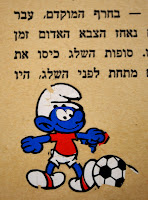
Friday, November 5, 2010
Proof of Life
Monday, October 25, 2010
Ten Years, Ten People: Beth Doyle
In this video I share a personal story of unexpectedly finding an image of one of my ancestors in our collections in the Rare Book, Manuscript, and Special Collection Library.
Saturday, October 23, 2010
Paper Crumbs
 We just finished our fall semester Care and Handling sessions wherein we give out tips on safely handling library materials. We also display our "show of horrors" which covers amongst other things torn pages, food spills, damaged spines, and of course brittle paper.
We just finished our fall semester Care and Handling sessions wherein we give out tips on safely handling library materials. We also display our "show of horrors" which covers amongst other things torn pages, food spills, damaged spines, and of course brittle paper. Tuesday, October 19, 2010
Care and Handling Training
This week we are presenting our annual week-long Care and Handling/Identifying Common Damage demonstrations. Each year we present our show of horrors to help new library staff and student assistants learn to identify damaged books. We also provide quick tips and helpful hints that can minimize potential damage when items are handled during our day-to-day work.
What we hope comes across is that everyone has a role to play in getting our materials to the shelf safely. We appreciate everyone's help in keeping our collections around for a very long time.
If you work in the library, stop in to see a demonstration. Our sessions for the rest of the week are as follows (sessions are held in the conservation lab-Perkins 023-unless otherwise indicated):
10/19, 4pm, 6pm
10/20, 11:30am, 3pm (at Lily Library)
10/21, 10am (at Smith Warehouse), 1pm
10/22, 9:30am, 2pm
Thursday, October 14, 2010
Mastering Craft
Our new exhibit highlights work from the Triangle Research Libraries (TRLN) Master Bookbinders Group. Our group consists of staff members from the conservation labs of UNC-Chapel Hill, NC State and Duke University libraries.
Its purpose is to research historic bookbindings so we can deepen our understanding of the history of the book, and develop knowledge and skills that help inform our daily conservation work.
Creating binding models is a traditional form of learning the craft of bookbinding and the history of the book. Each quarter we assign a binding style to one or two of our members. Our volunteer teachers research the history of the binding and how it was traditionally made, and demonstrate it to the rest of the group. We then make our models, sometimes recreating the binding exactly and sometimes interpreting them more artistically.
The exhibit will be up through January 2011, just outside the Conservation Lab in Perkins Library 023. It is open when the library is open.
Monday, October 11, 2010
Ten Years, Ten People: Meg Brown
Friday, October 8, 2010
Happy Anniversary Devil's Tale!
 As you may know, the traditional one-year anniversary gift is paper. As our one-year gift we give Devil's Tale this historic image of us working on a broadside (paper!) from the RBMSCL library collection. This happens to also be from our first post.
As you may know, the traditional one-year anniversary gift is paper. As our one-year gift we give Devil's Tale this historic image of us working on a broadside (paper!) from the RBMSCL library collection. This happens to also be from our first post.Monday, October 4, 2010
What Month Is It?
 In October we gather ourselves together to celebrate all that is good and important, like the North Carolina State Fair and All Hallows Eve. But did you know that among other celebrations October is:
In October we gather ourselves together to celebrate all that is good and important, like the North Carolina State Fair and All Hallows Eve. But did you know that among other celebrations October is:American Archives Month
National Medical Librarians Month
National Cybersecurity Awareness Month
National Graphic Novel Writing Month
National Arts and Humanities Month
National Book Month
National Breast Cancer Awareness Month
National Dental Hygiene Month
National Fire Safety Month
What are you celebrating this month?
Image from the Duke University History of Medicine Collection exhibits website.
Thursday, September 30, 2010
Reading Roundup
 I'm starting a recurring blog post called "Reading Roundup" to share some reading that you may find interesting. These links will be at least tangentially related to books, preservation, conservation and libraries. Here is the first installment. Enjoy!
I'm starting a recurring blog post called "Reading Roundup" to share some reading that you may find interesting. These links will be at least tangentially related to books, preservation, conservation and libraries. Here is the first installment. Enjoy!The Devil's Tale "Celebrates Banned Book Week." Share your banned book story with them.
The Chronicle of Higher Education asks whether digitized books "feel like a library" in "Digitizing The Personal Library."
Also in The Chronicle of Higher Education, "What Are Books Good For" questions when books became the enemy.
In The Library With A Lead Pipe (one of my favorite library blogs) ponders how to collect meaningful data about our instruction efforts in their post "Articulating Value in Special Collections."
Parks Library Preservation at Iowa State has a nicely written ode to Carolyn Harris and Paul Banks, leaders in our field. Read "Thank you Paul and Carolyn, et al," Then tell your favorite teacher or mentor how much they mean to you.
And finally over on Work of the Hand , our former staff member and student, Henry Hebert, is blogging about what he is learning in the book binding program at the North Bennett Street School this semester.
Image from Duke University Libraries Ad Access, click on image for details.
Friday, September 24, 2010
Word Cloud: 2010 Conservation Program Report
Monday, September 20, 2010
It's Better Than Christmas!
My fabulous student Anne unpacked and inventoried these in about two hours. Our shelves are fully stocked with brand new, shiny binders which means we can now get back to the business of preparing pamphlets for the shelf. Yippeee!
Thursday, September 16, 2010
Where Art and Libraries Meet
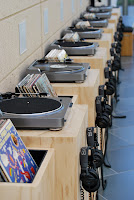 I had a few minutes after I was finished to see the current exhibits on display. "The Record: Contemporary Art and Vinyl" is a must-see (through February 6th, 2011). There is a combination of artwork that uses actual vinyl as part of the artwork, or uses the form of the discs or sleeves as inspiration. Some of the sculpture was fun, and there is mixed media, paintings, and video installations.
I had a few minutes after I was finished to see the current exhibits on display. "The Record: Contemporary Art and Vinyl" is a must-see (through February 6th, 2011). There is a combination of artwork that uses actual vinyl as part of the artwork, or uses the form of the discs or sleeves as inspiration. Some of the sculpture was fun, and there is mixed media, paintings, and video installations.Monday, September 13, 2010
Banks/Harris Award Nominations Sought
Nominations are being accepted for the 2011 Association for Library Collections & Technical Services (ALCTS) Paul Banks and Carolyn Harris Preservation Award. The deadline for nominations is December 1, 2010.
Banks/Harris Preservation Award:
The award was established to honor the memory of Paul Banks and Carolyn Harris, early leaders in library preservation. The award, $1,500 and a citation, sponsored by Preservation Technologies, L.P., is given to a professional preservation specialist who has been active in the field of preservation and/or conservation for library and/or archival materials. Winners will be chosen based on: leadership in professional associations at local, state, regional or national levels; contributions to the development, application or utilization of new or improved methods, techniques and routines; significant contribution to professional literature; evidence of studies or research in preservation; and training and mentoring in the field of preservation.
Send nominations, a formal statement of nomination that provides a strong rationale for the nomination by addressing how the nominee meets the criteria for the award, letters of support for the nomination and a complete resume for the nominee to:
Hilary Seo, chair, Banks/Harris Jury
Iowa State University
441 Parks Library
Ames, IA 50011-2140
For more information about the award and past recipients visit the Banks Harris page.
Further questions about the award are welcome and may be directed to any of the committee members:
Beth Doyle, b.doyle@duke.edu
Jake Nadal, jnadal@library.ucla.edu
Lene Palmer, lenep@gmu.edu
Hilary Seo, hseo@iastate.edu
Peter D. Verheyen, pdverhey@syr.edu
Wednesday, September 8, 2010
Saving Serials
Friday, September 3, 2010
TRLN Bookbinders: Paper Case Binding
Tuesday, August 31, 2010
Boxing Day Favorites
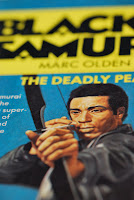 As you loyal readers already know Boxing Day comes around every month, in fact it now comes around twice a month because we have so much coming into the collections that need enclosures. We crank out the work on Boxing Day but we also get to stop ever so briefly to take a closer look at some of the materials.
As you loyal readers already know Boxing Day comes around every month, in fact it now comes around twice a month because we have so much coming into the collections that need enclosures. We crank out the work on Boxing Day but we also get to stop ever so briefly to take a closer look at some of the materials.Friday, August 27, 2010
Saying Farewell
 It's a bittersweet week here in the lab. We are losing two of our family who are off to start careers and take on new adventures.
It's a bittersweet week here in the lab. We are losing two of our family who are off to start careers and take on new adventures.Tuesday, August 24, 2010
Our First Label

It may seem silly to be so exuberant about a label, but conservators get excited about weird things (anyone want to talk paste recipes?). We have finally procured a Kwikprint so that we can make lovely, gold foil labels for our rebinds. Erin modified one of our taborets to use as a base and has set up the machine. She printed our first label last week, and it is truly something to celebrate.
Friday, August 20, 2010
Erin's Summer Adventures
 I just returned from two fantastic professional development opportunities. First, I attended the Ligatus Summer School class on the History of European Bookbinding 1500-1800, held this year at the Herzog August Bibliothek in Wolfenbüttel, Germany.
I just returned from two fantastic professional development opportunities. First, I attended the Ligatus Summer School class on the History of European Bookbinding 1500-1800, held this year at the Herzog August Bibliothek in Wolfenbüttel, Germany.Drawing from the instructor Nicholas Pickwoad’s research and using examples from the library’s collection, the class examined how changes in the style and structure of book bindings produced during this period can illustrate the effects of changing pressures and developments in the book trade and in the printing and bookbinding industries at the time.
The class will allow me and my fellow conservators to better contextualize the bindings we comes across during the course of our work as conservators as well as enable us to identify, document, and preserve critical evidence during treatment.
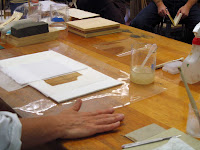 I then went to a workshop taught by Renate Mesmer, Assistant Head of Conservation at the Folger Shakespeare Library in Washington, D.C. The workshop Tips & Tricks for Book and Paper Conservation was held in the bookbinding studio at North Bennet Street School in Boston.
I then went to a workshop taught by Renate Mesmer, Assistant Head of Conservation at the Folger Shakespeare Library in Washington, D.C. The workshop Tips & Tricks for Book and Paper Conservation was held in the bookbinding studio at North Bennet Street School in Boston.It was packed full of practical techniques and handy tricks that Ms. Mesmer has amassed during her 30+ years as a bookbinder, conservator and educator. The tips ranged from pulp-filling paper losses, performing corner and leather repairs, and to creating a new flexible leather binding.
I am really looking forward to sharing these techniques with my colleagues in Conservation and to putting them to good use in my treatments.
Monday, August 16, 2010
10 Years, 10 People: Mary Yordy, Senior Conservation Technician
Thursday, August 12, 2010
Burnt and Bent
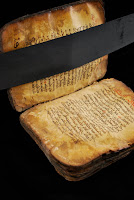
Clearly it's seen better days, but it is remarkable nonetheless. It looks to be to have survived a fire, at least the middle of the text block survived. The front third or so was burned off, leaving stubs that are still attached to the binding, but the spine has curled in on itself. The remaining vellum pages range from really brittle to fairly OK, if a little warped.
Thursday, August 5, 2010
10 Years, 10 People: Rachel Ingold
Sunday, August 1, 2010
Boxing the Devil

This little devil came to the lab from the University Archives for an enclosure. I put up a photo essay over on Flickr about how the box is constructed, and we posted about it over on Devil's Tale.
Friday, July 30, 2010
What We Find In Books: Blaeu Bears and Deer

 Erin came across these illustrations in one of the Blaeu atlases that she has been working on. These are filled with lovely, hand painted images.
Erin came across these illustrations in one of the Blaeu atlases that she has been working on. These are filled with lovely, hand painted images.We've been having a little fun trying to figure out what the bears were saying to each other, and whether this deer is from the lost herd of vampire deer from Transylvania. In all seriousness, look how it is ever so daintily standing on the frame whilst seemingly taking a nap. Very skillful (both the illustrator and the deer itself).
*Illustrations from: Willem Janszoon Blaeu, "Toonneel des aerdriicx, ofte nievwe atlas, dat is Beschryving van alle landen; nu nieulycx uytgegeven." (E ff#91 dl.1 - 1649)
Tuesday, July 27, 2010
10 years, 10 people: Erin Hammeke
When asked about a favorite project, Erin replies:
 "Currently I am working on a volume of De Bry's account of the New World, and this has been an extremely fun and challenging treatment that has involved paper repair, resewing the text, and rebinding in full calf leather. I am also wrapping up treatment of the Blaeu Atlases, six large Dutch atlases that were printed in the mid-1600s and hand painted with an inspired and vibrant color palette.
"Currently I am working on a volume of De Bry's account of the New World, and this has been an extremely fun and challenging treatment that has involved paper repair, resewing the text, and rebinding in full calf leather. I am also wrapping up treatment of the Blaeu Atlases, six large Dutch atlases that were printed in the mid-1600s and hand painted with an inspired and vibrant color palette.Over the past three years that I have spent at Duke, my main focus has been on the conservation of the Jantz Collection of German Baroque materials and German Americana. I love working with this collection because it seems to have everything - both in terms of content (there are materials that pertain to history,travel, the occult, women's writings, and more) and in terms of different binding styles and materials. For the most part, I am drawn to the more mundane items and the stories they tell about how they were made, why they were collected, by whom, and how they were used and cared for. I have found the Jantz Collection to be particularly rich with these stories."
*Top illustrations from: Willem Janszoon Blaeu, "Toonneel des aerdriicx, ofte nievwe atlas, dat is Beschryving van alle landen; nu nieulycx uytgegeven." (E ff#91 dl.5 - 1654.) Lower illustration: books from the Jantz Collection of German Baroque materials.
Wednesday, July 21, 2010
Papyrus Project
Wednesday, July 14, 2010
10 Years, 10 Treatments


 Yesterday we installed our exhibit "Ten Years, Ten Treatments." As part of our year-long celebration of our tenth anniversary, we wanted to highlight some of our favorite work.
Yesterday we installed our exhibit "Ten Years, Ten Treatments." As part of our year-long celebration of our tenth anniversary, we wanted to highlight some of our favorite work.Friday, July 9, 2010
Here's Your Mule
Mary has been repairing the tears and losses on this broadside with Japanese tissue and wheat starch paste. After the tissue is applied, a blotter is placed on top with a weight until dry. When the digitization is complete, these will come back to Conservation for rehousing.
Thursday, July 8, 2010
Ethiopic Manuscript Digitization Project
Tuesday, June 29, 2010
Ten Years, Ten People: Rita Johnston, Digitization Assistant for Road 2.0 Project
 Rita Johnston, Digitization Assistant for ROAD 2.0 project has been with the department for one year. She is digitizing outdoor advertising materials described in the Resource of Outdoor Advertising Descriptions database. The bulk of materials being digitized for this project are from the OAAA Archives and OAAA Slide Library collections, but some images from the John Paver Papers and the John E. Brennan Survey Reports are also included.
Rita Johnston, Digitization Assistant for ROAD 2.0 project has been with the department for one year. She is digitizing outdoor advertising materials described in the Resource of Outdoor Advertising Descriptions database. The bulk of materials being digitized for this project are from the OAAA Archives and OAAA Slide Library collections, but some images from the John Paver Papers and the John E. Brennan Survey Reports are also included.The project includes about 15,000 photographs and negatives which Rita has digitized, and I have about 12,000 slides which she has sent to a vendor for digitization. She uses different equipment including flatbed scanners and the Zeutschel 14000 A2 scanner for photographs and the Phase One Camera for transparent materials such as negatives. Rita is wrapping up the digitization phase of the project and will begin focusing her attention on normalization and cleanup of the metadata in the ROAD database.
When asked what is the most interesting collection you have worked with, Rita replied:
Since I have mostly been working with materials from the OAAA Archives, the OAAA Archives is the most interesting collection I have worked with. There is a great deal of variety in the content and types of materials in the collection. Much of the subject matter is of billboards, art designs, and other forms of outdoor advertising from the 1910s to the early 1980s.We are all eagerly awaiting Rita's project to be online. Thanks Rita for all of your hard work!
The subject matter includes food & beverages, local businesses, political propaganda, cars, financial institutions, movies, and of course, beer and cigarettes. It’s really interesting to see how much billboards have changed over time, from the beautiful hand painted signs of the early to mid 20th century to machine printed billboards of later years.There are even a few interesting examples in the collection of cellulose acetate negatives breaking down. All negatives are prone to deterioration over time, and the process may be sped up if negatives are exposed to high heat and humidity. Some of the negatives smell strongly of vinegar and are warped and cracked where the emulsion is breaking down.
Thursday, June 24, 2010
Stop the Presses! Conservation is in the news
Monday, June 21, 2010
Ten Years, Ten People: Mike Adamo, Digital Production Developer
As a Digital Production Developer Mike assess Library collections for digitization, creates images for high end print projects, and designs workflows for digitization projects in the Digital Production Center. He is also responsible for calibrating and maintaining the various cameras and scanners that they use in their daily operations.
When asked about his favorite preservation project, Mike responded:
You can see some of the work that Mike and the DPC staff on the Digital Collections Blog.My favorite project over the years has been building the Digital Production Center. When I started on March 14, 2005, the Digital Production Center was located on Perkins lower level behind the copy room and was often used as a shortcut from the lower level to the RBMSCL. We had one Epson Expression 10000 and a BetterLight scanback fresh out of the box. The camera room had previously been a traditional wet darkroom. The sinks had been removed but some of the plumbing remained jutting out of the walls and though the tiles had been scrubbed clean the chemical stains from years past were still present.
The questions at the time were: What is a digital collection? How do we represent the physical item digitally? What metadata scheme should we use and how do we capture it? While from a distance these questions seem fairly simple and straight forward once we started building digital collections we had to apply the concepts of sustainability and scalability while being as transparent as possible. Easy… right?
Since then, we have moved 3 times and are now in our permanent space (I think). This space was specifically designed with the Digital Production Center in mind. Our air handler is HEPA filtered, the lighting is full spectrum, the monitors are color calibrated, the walls are 18% gray, the floor is cork and we have a large vault that we share with Conservation.We added another flatbed scanner, a dedicated quality control station, a P65 Phase One R-Cam, a Zeutschel 14000 A2, a SAMMA Solo video encoder a high-end light table (for digitizing negatives on the Phase One), 2 FTE, additional students and a database to track production and collect technical metadata. In addition to all of this a few months ago we added a Scribe book scanner through the Internet Archive. Our production rates have gone from 4000 + digital images the first year to a projected 100,000 digital images this year and that doesn’t include the images created using the Scribe.
We have come a long way in a short time.
Friday, June 11, 2010
TRLN Bookbinders: Islamic Binding
 The interesting thing about Islamic bindings is that they haven't changed much. According to Jane Greenfield in "ABC of Bookbinding," the format was likely learned from binders in Ethiopia. This structure strongly influenced bookbinding in Europe, traveling through Italy and Spain.
The interesting thing about Islamic bindings is that they haven't changed much. According to Jane Greenfield in "ABC of Bookbinding," the format was likely learned from binders in Ethiopia. This structure strongly influenced bookbinding in Europe, traveling through Italy and Spain.

